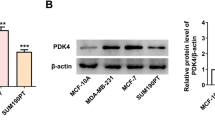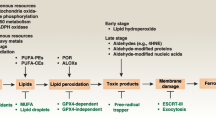Abstract
AflatoxinB1 (AFB1) is well known as a potent carcinogen. Epidemiological studies have shown an association between AFB1 exposure and lung cancer in humans. AFB1 can induce the mutations of genes such as tumor suppressor p53 through its metabolite AFB1-8,9-exo-epoxide, which acts as a mutagen to react with DNA. In addition, recent study demonstrates AFB1 positively regulates type I insulin-like growth factor receptor (IGF-IR) signaling in hepatoma cells. The current study aims to determine the effects of AFB1 on Src kinase and insulin receptor substrate (IRS) in lung cancer cells and the effects of AFB1 on lung cancer cell migration. To this end, the effects of AFB1 on IRS expression, Src, Akt, and ERK phosphorylation were measured by Western blot analysis. The migration of lung cancer cells was detected by wound-healing assay. AFB1 downregulates IRS1 but paradoxically upregulates IRS2 through positive regulation of the stability of IRS2 and the proteasomal degradation of IRS1 in lung cancer cell lines A549 and SPCA-1. In addition, AFB1 induces Src, Akt, and ERK1/2 phosphorylation. Treatment of lung cancer cells with Src inhibitor saracatinib abrogates AFB1-induced IRS2 accumulation. Moreover, AFB1 stimulates lung cancer cell migration, which can be inhibited by saracatinib. We conclude that AFB1 may upregulate IRS2 and stimulate lung cancer cell migration through Src.





Similar content being viewed by others
References
Williams JH, Phillips TD, Jolly PE, Stiles JK, Jolly CM, Aggarwal D. Human aflatoxicosis in developing countries: a review of toxicology, exposure, potential health consequences, and interventions. Am J Am J Clin Nutr. 2004;80:1106–22.
Massey TE, Smith GB, Tam AS. Mechanisms of aflatoxin B1 lung tumorigenesis. Exp Lung Res. 2000;26:673–83.
Donnelly PJ, Stewart RK, Ali SL, Conlan AA, Reid KR, Petsikas D, et al. Biotransformation of aflatoxin B1 in human lung. Carcinogenesis. 1996;17:2487–94.
Coulombe RA. Non-hepatic disposition and effects of aflatoxin B1. In: Eaton DL, Groopman JD, editors. The toxicology of aflatoxins, human health, veterinary and agricultural significance. San Diego: Academic; 1994. p. 89–101.
Dvorackova I, Stora C, Ayraud N. Evidence for aflatoxin B1 in two cases of lung cancer in man. J Cancer Res Clin Oncol. 1981;100:221–4.
Harrison JC, Garner RC. Immunological and HPLC detection of aflatoxin adducts in human tissues after an acute poisoning incident in S.E. Asia. Carcinogenesis. 1991;12:741–3.
Eaton DL, Ramsdell HS, Neal GE. Biotransformation of aflatoxins. In: Eaton DL, Groopman JD, editors. The toxicology of aflatoxins, human health, veterinary and agricultural significance. San Diego: Academic; 1994. p. 45–72.
Essigmann JM, Croy RG, Bennett RA, Wogan GN. Metabolic activation of aflatoxin B1: patterns of DNA adduct formation, removal, and excretion in relation to carcinogenesis. Drug Metab Rev. 1982;13:581–602.
Kensler TW, Roebuck BD, Wogan GN, Groopman GD. Aflatoxin: a 50-year odyssey of mechanistic and translational toxicology. Toxicol Sci. 2011;120:S28–48.
Garner RC, Miller EC, Miller JA. Liver microsomal metabolism of aflatoxin B1 to a reactive derivative toxic to Salmonella typhimurium TA1530. Cancer Res. 1972;32:2058–66.
Hertzog PJ, Smith JR, Garner RC. Characterisation of the imidazole ring-opened forms of trans-8,9-dihydro-8,9-dihydro-8-(7-guanyl)9-hydroxy aflatoxin B1. Carcinogenesis. 1982;3:723–5.
an Vleet TR, Watterson TL, Klein PJ, Coulombe Jr RA. Aflatoxin B1 alters the expression of p53 in cytochrome P450-expressing human lung cells. Toxicol Sci. 2006;89:399–407.
Ma Y, Kong Q, Hua H, Luo T, Jiang Y. Aflatoxin B1 up-regulates insulin receptor substrate 2 and stimulates hepatoma cell migration. PLoS One. 2012;7:e47961.
Zhang S, Yu D. Targeting Src family kinases in anti-cancer therapies: turning promise into triumph. Trends Pharmacol Sci. 2012;33:122–8.
Rothschild SI, Gautschi O, Haura EB, Johnson FM. Src inhibitors in lung cancer: current status and future directions. Clin Lung Cancer. 2010;11:238–42.
Masaki T, Igarashi K, Tokuda M, Yukimasa S, Han F, Jin YJ, et al. pp60c-src activation in lung adenocarcinoma. Eur J Cancer. 2003;39:1447–55.
Mazurenko NN, Kogan EA, Zborovskaya IB, Kisseljov FL. Expression of pp60c-src in human small cell and non-small cell lung carcinomas. Eur J Cancer. 1992;28:372–7.
Playford MP, Schaller MD. The interplay between Src and integrins in normal and tumor biology. Oncogene. 2004;23:7928–46.
Trevino JG, Summy JM, Gray MJ, Nilsson MB, Lesslie DP, Baker CH, et al. Expression and activity of Src regulate interleukin-8 expression in pancreatic adenocarcinoma cells: implications for angiogenesis. Cancer Res. 2005;65:7214–22.
Kim LC, Song L, Haura EB. Src kinases as therapeutic targets for cancer. Nat Rev Clin Oncol. 2009;6:587–95.
Sun H, Baserga R. The role of insulin receptor substrate-1 in transformation by v-src. J Cell Physiol. 2008;215:725–32.
Sun HZ, Xu L, Zhou B, Zang WJ, Wu SF. Depletion of insulin receptor substrate 2 reverses oncogenic transformation induced by v-src. Acta Pharmacol Sin. 2011;32:611–8.
Giovannone B, Scaldaferri ML, Federici M, Porzio O, Lauro D, Fusco A, et al. Insulin receptor substrate (IRS) transduction system: distinct and overlapping signaling potential. Diabetes Metab Res Rev. 2000;16:434–41.
White MF. The IRS-signalling system in insulin and cytokine action. Philos Trans R Soc Lond B Biol Sci. 1996;351:181–9.
Ubagai T, Kikuchi T, Fukusato T, Ono Y. Aflatoxin B1 modulates the insulin-like growth factor-2 dependent signaling axis. Toxicol In Vitro. 2010;24:783–9.
Sun Z, Shushanov S, LeRoith D, Wood TL. Decreased IGF type 1 receptor signaling in mammary epithelium during pregnancy leads to reduced proliferation, alveolar differentiation, and expression of insulin receptor substrate (IRS)-1 and IRS-2. Endocrinology. 2011;152:3233–45.
Gao L, Wang X, Wang X, Zhang L, Qiang C, Chang S, et al. IGF-1R, a target of let-7b, mediates crosstalk between IRS-2/Akt and MAPK pathways to promote proliferation of oral squamous cell carcinoma. Oncotarget. 2014;5:2562–74.
Long Y, Cheng Z, Copps KD, White MF. Insulin receptor substrates Irs1 and Irs2 coordinate skeletal muscle growth and metabolism via the Akt and AMPK pathways. Mol Cell Biol. 2011;31:430–41.
Solinas G, Naugler W, Galimi F, Lee MS, Karin M. Saturated fatty acids inhibit induction of insulin gene transcription by JNK-mediated phosphorylation of insulin-receptor substrates. Proc Natl Acad Sci U S A. 2006;103:16454–9.
Shah OJ, Wang Z, Hunter T. Inappropriate activation of the TSC/Rheb/mTOR/S6K cassette induces IRS1/2 depletion, insulin resistance, and cell survival deficiencies. Curr Biol. 2004;14:1650–6.
Gibson SL, Ma Z, Shaw LM. Divergent roles for IRS-1 and IRS-2 in breast cancer metastasis. Cell Cycle. 2007;6:631–7.
Im SH, Bolt MW, Stewart RK, Massey TE. Modulation of aflatoxin B1 biotransformation by β-naphthoflavone in isolated rabbit lung cells. Arch Toxicol. 1996;71:72–9.
Allameh A, Saxena M, Raj HG. Differential effects of butylated hydroxyanisole on metabolism of aflatoxin B1 in vitro by liver and lung microsomes. Cancer Lett. 1988;40:49–57.
Acknowledgments
We thank for the support from National Natural Science Foundation of China (No. 81272215).
Conflicts of interest
None
Author information
Authors and Affiliations
Corresponding authors
Rights and permissions
About this article
Cite this article
Cui, A., Hua, H., Shao, T. et al. Aflatoxin B1 induces Src phosphorylation and stimulates lung cancer cell migration. Tumor Biol. 36, 6507–6513 (2015). https://doi.org/10.1007/s13277-015-3341-2
Received:
Accepted:
Published:
Issue Date:
DOI: https://doi.org/10.1007/s13277-015-3341-2




